Solar Cables Market Research, 2032
The global solar cables market was valued at $0.9 billion in 2022, and is projected to reach $2.9 billion by 2032, growing at a CAGR of 12.4% from 2023 to 2032.
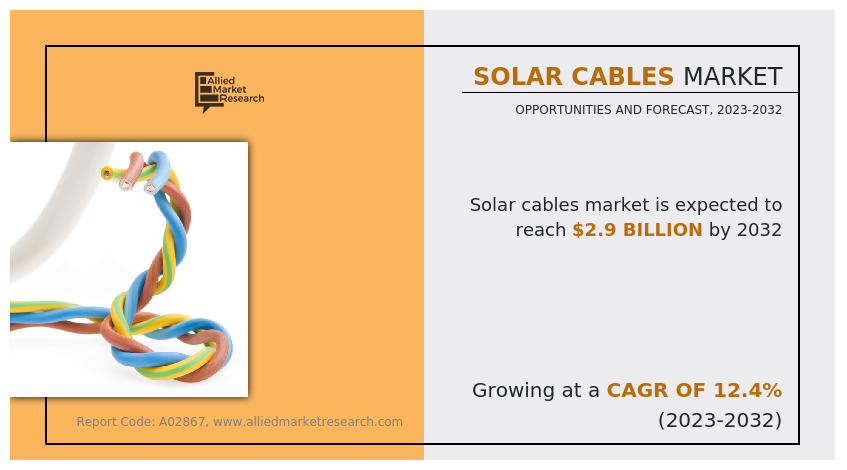
Solar cable is in particular beneficial for connecting solar panels to other solar power system aspects such as inverters, charge controllers, and batteries. It is responsible for the conversion of the direct current (DC) generated by solar panels to the alternating current (AC) used in homes, businesses, and the power grid. Solar cables are crucial in the renewable energy sector, specifically in the technology and distribution of photovoltaic power. It is designed to withstand the special challenges that photo voltaic installations present, which makes them a vital component of the photovoltaic power ecosystem.
The adoption of photovoltaic energy as a smooth and sustainable power supply has resulted in substantial growth in the solar cable market. One of the important benefits of solar cables is their capability to withstand excessive temperatures. They are usually designed with UV-resistant substances and are successful in utilizing solar cables effectively even in severe temperatures, ensuring reliable average overall performance and longevity.
Solar cables are acknowledged for their incredible electrical properties, durability, low transmission losses, and high efficiency, which are crucial for optimizing power generation and minimizing power wastage. These aspects make them as suitable for large-scale solar farms as residential solar installations. Furthermore, solar cables are designed exceptionally flexible, making them effortless to install in difficult terrains or irregular layouts. This flexibility allows for seamless integration of solar panels on rooftops, in remote areas, and even on mobile or portable solar setups.
The widespread application of solar cables is observed in both utility-scale solar projects and small-scale residential installations. In utility-scale projects, where vast arrays of solar panels are deployed, solar cables form an essential backbone for efficient power transmission. In residential installations, solar cables allow homeowners to harness solar energy for their daily electricity needs, potentially lowering dependence on the traditional grid and decreasing electricity costs. As the demand for renewable energy continues to grow, the solar cable market is anticipated to increase in demand further. Technological advancements will lead to innovations, which include higher efficiency, accelerated safety features, and increased ease of installation.
Despite their advantages, solar cables also face some limitations. The distance over which solar cables effectively transmit power is subject to limitations due to resistive losses, which impact power output over long cable runs. Therefore, proper sizing and installation planning are essential to optimize the performance of solar energy systems.
"The advancements in solar applications in various end-use for power generation"
The solar cables market has witnessed significant growth due to the remarkable advancements in solar applications for power generation across various end-uses. From the residential sector to commercial and industrial applications, solar energy has become a prominent sustainable alternative to conventional power sources. The integration of cutting-edge solar cables has played a vital role in enhancing energy transfer efficiency and promoting the widespread adoption of solar technology. In addition, the agricultural sector has benefited from solar-powered irrigation systems, providing farmers with eco-friendly solutions for water pumping.
Moreover, solar energy has penetrated the automotive industry, with solar-powered electric vehicles using advanced solar cables to extend their driving range. In remote areas, solar-powered infrastructure, facilitated by high-quality solar cables, has brought sustainable power solutions to regions with limited access to traditional grids. As these innovations continue to drive the global renewable energy transition, the solar cables market remains essential in paving the way toward a greener and more sustainable future.
The solar cables market is segmented on the basis of material type, type, end-use, and region. By material type, the market is classified into copper, aluminum, and others. By type, the market is divided into solid and stranded. By end use, the market is categorized into residential, commercial, and industrial. By region, the market is analyzed across North America, Europe, Asia-Pacific, and LAMEA.
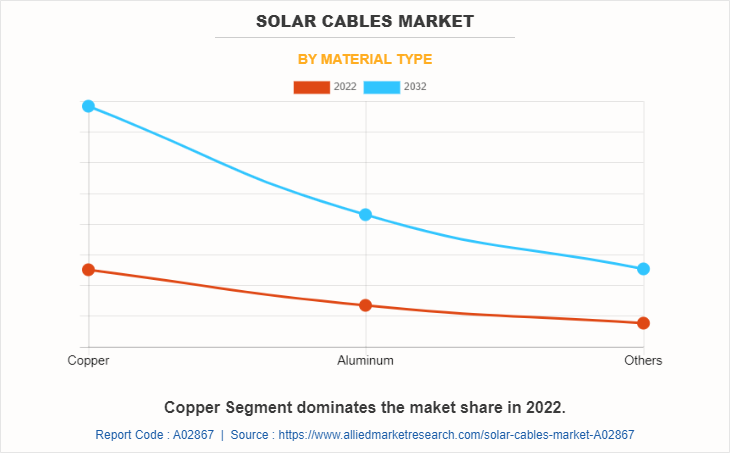
Based on material type, the copper segment held the highest solar cables market size in terms of share in 2022, accounting for more than half of the global market revenue, and is estimated to maintain its leadership status throughout the solar cables market forecast. The increasing adoption of rooftop solar installations is one of the key trends in the copper solar cables market.
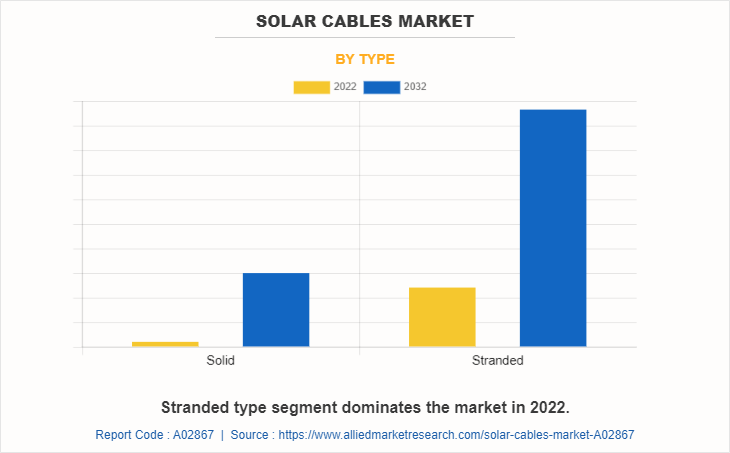
Based on type, the stranded segment held the highest market share in 2022, accounting for nearly three-fourths of the global solar cables market revenue, and is estimated to maintain its leadership status throughout the forecast period. As solar power installations continue to expand globally, there is a growing demand for reliable and efficient solar cables that withstand the environmental challenges associated with outdoor use.
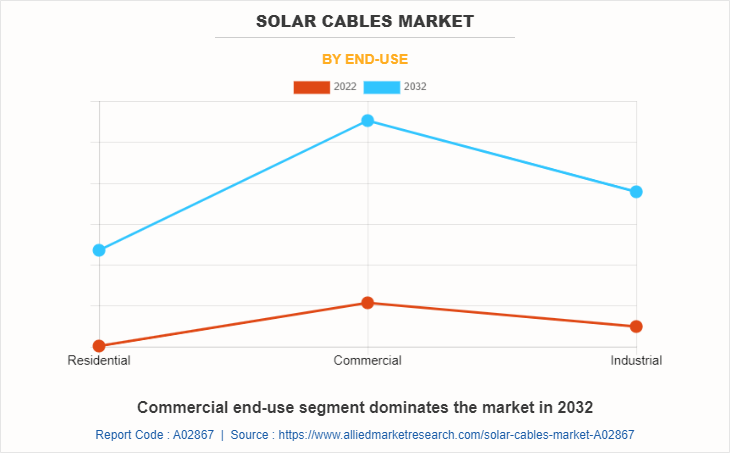
Based on the end-use, the commercial held the highest market share in 2022, accounting for nearly half of the global solar cables market revenue, and are estimated to maintain their leadership status throughout the forecast period. The rising global focus on sustainability and renewable electricity is driving the adoption of solar energy systems in commercial & industrial establishments, spurring the demand for solar cables.
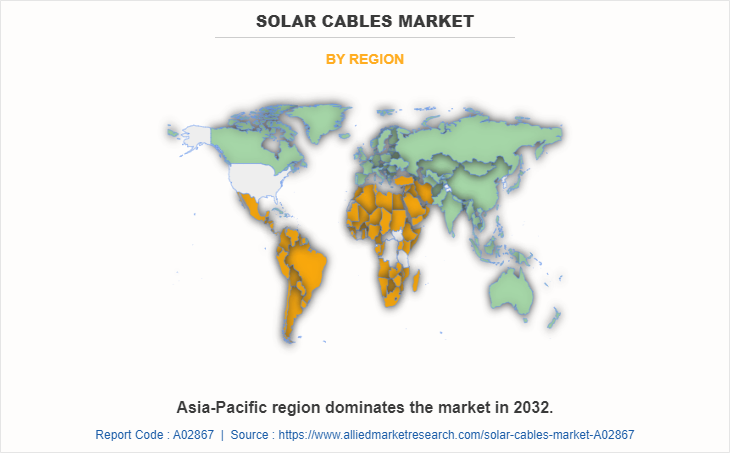
Based on region, Asia-Pacific held the highest market share in terms of revenue in 2022, accounting for more than two-fifths of the global solar cables market revenue, and is likely to dominate the market during the forecast period. Furthermore, the Asia-Pacific region is expected to witness the fastest CAGR of 12.8% from 2023 to 2032. The increasing commitment of governments to renewable energy targets and climate change mitigation, driving a surge in solar installations.
Key players in the solar cables industry include Prysmian Group, General Cable Technologies Corporation, Lapp Group, Nexans, Leoni AG, HELUKABEL, Top Cable, KEI Industries Limited, Havells India Ltd., and Belden Inc. In addition, to the abovementioned profiled companies, Southwire Company, LLC, TPC Wire & Cable Corp., Polycab India Limited, Alpha Wire, Encore Wire Corporation, JinkoSolar Holding Co., Ltd., SolarWorld AG, Relemac Technologies Pvt. Ltd., Tai Sin Electric Limited, CMI Limited, Finolex Cables Limited, Encore Wire Corporation, Ram Ratna Group, Okaya Power Group, Unika Cables, Sun Cable, HUBER+SUHNER AG, Eland Cables, and Wuxi Jiangnan Cable Co., Ltd are also part of solar cable market. These players have adopted various strategies such as acquisition, product launch, and investment toward R & D to gain a higher share or retain leading positions in the market.
Impact of various strategies and targets of major countries related to solar power generation and its impact on the solar cables market:
India: India has emerged as one of the leading countries in solar power generation. In 2021, the Indian government announced its plan to achieve 280 gigawatts (GW) of renewable energy capacity, including solar, by 2030. This aggressive target has led to substantial investments in solar projects, driving the demand for solar cables to connect the growing number of solar installations to the grid.
China: As the world's largest producer and consumer of solar panels, China has set ambitious solar energy targets as part of its efforts to combat air pollution and reduce its carbon footprint. In 2020, the Chinese government raised its solar capacity target to 300 GW by 2030, up from the previous goal of 105 GW. Such expansion in solar power capacity has created a massive market for solar cables to support the increased electricity transmission.
U.S.: The U.S. has been actively promoting renewable energy, and solar power is a key component of its clean energy transition. Several states in the U.S. have established ambitious renewable energy targets. For instance, California aims to achieve 100% clean energy by 2045, while New York has set a goal to produce 70% of its electricity from renewable sources by 2030. These targets have led to substantial investments in solar power projects and subsequently contributed to the growth of the solar cables market in the country.
European Union (EU): The EU has been at the forefront of renewable energy adoption. As part of its Green Deal initiative, the EU aims to increase the share of renewable energy to 32% by 2030. This includes significant investment in solar power generation across member states, driving the demand for solar cables and associated infrastructure.
Australia: Australia has abundant solar resources and has witnessed remarkable growth in solar installations. The country's government has set a Renewable Energy Target (RET) aiming for 33,000 gigawatt-hours of additional renewable energy generation by 2020. This target has attracted substantial investments in solar projects and stimulated the solar cables market in the region.
The combined impact of these countries' investments and targets on solar power generation has created a booming market for solar cables. As more solar power facilities are established and integrated into energy grids, the demand for efficient and reliable solar cables is expected to continue to grow, driving innovations in cable technology and production.
Key Benefits For Stakeholders
- This report provides a quantitative analysis of the market segments, current trends, estimations, and dynamics of the solar cables market analysis from 2022 to 2032 to identify the prevailing solar cables market opportunities.
- The market research is offered along with information related to key drivers, restraints, and opportunities.
- Porter's five forces analysis highlights the potency of buyers and suppliers to enable stakeholders make profit-oriented business decisions and strengthen their supplier-buyer network.
- In-depth analysis of the solar cables market segmentation assists to determine the prevailing market opportunities.
- Major countries in each region are mapped according to their revenue contribution to the global solar cables market growth.
- Market player positioning facilitates benchmarking and provides a clear understanding of the present position of the market players.
- The report includes the analysis of the regional as well as global solar cables market trends, key players, market segments, application areas, and market growth strategies.
Solar Cables Market Report Highlights
| Aspects | Details |
| Market Size By 2032 | USD 2.9 billion |
| Growth Rate | CAGR of 12.4% |
| Forecast period | 2022 - 2032 |
| Report Pages | 280 |
| By Material Type |
|
| By Type |
|
| By End-Use |
|
| By Region |
|
| Key Market Players | Lapp Group, Belden Inc., KEI Industries Limited, Prysmian Group, JainFlex Cables Pvt. Ltd., Havells India Ltd, Leoni AG, Top Cable, HELU KABEL GmbH, Nexans S.A. |
| Other Key Market Players | Yueqing Feeo Electric, Changzhou Painuo Electronic, Shanghai Jiukai Wire & Cable |
Analyst Review
As per the insights of CXOs in the solar cables market, they recognize a substantial growth potential driven by various factors. One of the predominant drivers is the global shift in the direction of renewable energy sources and the adoption of solar power generation. CXOs recognize that there is a surge in demand for exceptional solar cables that effectively transmit solar power from photovoltaic panels to energy grids or storage systems.
According to the CXOs, the solar cables market is expected to witness a widespread boom in the coming years, as solar power becomes a more crucial section of the global power mix. To stay competitive and meet the evolving needs of customers, CXOs understand the importance of offering advanced and innovative features in their solar cable products. This includes incorporating cutting-edge materials and technologies to enhance the efficiency and reliability of solar energy transmission.
Sustainability is a key focus of CXOs in the solar cables market. They recognize that environmentally responsible solutions are highly valued by customers, stakeholders, and regulators. Therefore, CXOs strive to develop and promote solar cables that are efficient and have minimal environmental impact. This includes using sustainable materials, optimizing manufacturing processes to reduce waste and energy consumption, and supporting eco-friendly installation practices.
Moreover, CXOs are keen on leveraging technological advancements to drive growth and innovation in the solar cables market. They emphasize staying at the forefront of emerging technologies such as smart grid integration, energy storage, and advanced monitoring systems. By integrating these technologies into their solar cables, CXOs aim to provide solutions that enhance the overall efficiency and reliability of solar power systems.
Integration with energy storage, and grid integration and energy management are the upcoming trends of solar cables market in the world.
Rapid growth of solar power installations, environmental concerns and climate change, and increase in electricity demand are the driving factors for the Solar Cables Market growth.
Commercial is the leading application of Solar Cables Market.
Asia-Pacific is the largest regional market for solar cables.
$2.9 billion is the estimated industry size of solar cables by 2032.
Prysmian Group, Belden Inc, KEI, Lapp Group, and Havells India Ltd. are the top companies to hold the market share in Solar Cables
Loading Table Of Content...
Loading Research Methodology...



